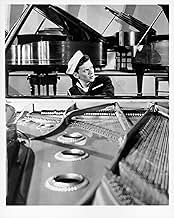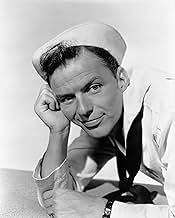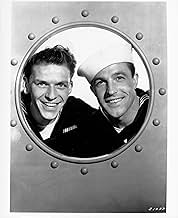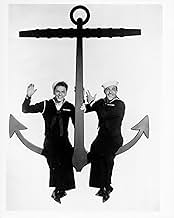CALIFICACIÓN DE IMDb
7.0/10
9.8 k
TU CALIFICACIÓN
Un par de marinos de baja intentan ayudar a un extra de cine a convertirse en una estrella de la música.Un par de marinos de baja intentan ayudar a un extra de cine a convertirse en una estrella de la música.Un par de marinos de baja intentan ayudar a un extra de cine a convertirse en una estrella de la música.
- Dirección
- Guionistas
- Elenco
- Ganó 1 premio Óscar
- 5 premios ganados y 4 nominaciones en total
Rags Ragland
- Police Sergeant
- (as 'Rags' Ragland)
Carlos Ramírez
- Carlos
- (as Carlos Ramirez)
- Dirección
- Guionistas
- Todo el elenco y el equipo
- Producción, taquilla y más en IMDbPro
Resumen
Reviewers say 'Anchors Aweigh' is a classic MGM musical with Gene Kelly, Frank Sinatra, and Kathryn Grayson. It features memorable dance sequences, vibrant Technicolor, and innovative camera work. Themes of love, friendship, and ambition are explored. Songs by Jule Styne and Sammy Cahn enhance the charm. Despite some criticisms of length and pacing, the film is celebrated for its entertainment value and historical significance.
Opiniones destacadas
Since I first saw Anchors Aweigh in 1945, viewing it on videotape holds a lot of nostalgia for me. At age 15, it was easy for me to be drawn into the first of the great MGM Technicolor musicals. Now I am perhaps most interested in thinking about the future careers of the leading players. Though Sinatra had done a couple of negligible films soon after his emergence after his Dorsey days, as a solo singer, this was his first major film appearance. As another viewer noted, this seems almost to be a warm-up for On the Town. Sinatra may have had to work hard at it, but his dance with Kelly is credible, and he would do better in their next pairings. However, observing his physique, it's easy to see why he was caricatured as a string bean. Who would have imagined that within a decade he would win an academy award for acting, and go on to play many roles as a tough detective or leader in combat. Though Gene Kelly's personality and dancing dominated this film, his winsome performance did not suggest that he would become a major creative force, almost the iconic figure, for MGM musicals, where he developed a style of dance complementary to that of Fred Astaire. Finally, it was strange to see the fresh-faced Dean Stockwell and remember that he would later play a "thrill" killer in Compulsion, based on the Leopold-Loeb murder from the 1920s. An additional note: One reviewer praised the performance of Betty Garrett as Sinatra's love interest. She later played opposite him in On the Town, but Pamela Britton was featured in this film.
Famous for the scene where Gene Kelly dances a duet with Jerry Mouse, this zippy musical is also the one where Kathryn Grayson trills 'Jealousy', and Frank Sinatra sings in the arena of a thousand pianos ('I Fall in Love Too Easily'). Grayson is a young mother who wants more than anything else to be in the movies. Her little boy (Dean Stockwell, who would turn up much later in TV's Quantum Leap) wants to join the US forces, and so he meets sailors Kelly and Sinatra heading out for a bit of leave. There are some echoes of 'On the Town' in this movie, but not enough to spoil the mix.
Released some months before the end of the war, "Anchors Aweigh" is one of Gene Kelly's major musical triumphs of the forties
Under the direction of George Sidney, it had the benefits of a pleasant score, andbest of allthe services of Gene Kelly in his first true starring role at MGM The year before, in Columbia's "Cover Girl," he had revealed an innovative approach to dance on the screen, a light but agreeable singing voice, and considerable charm In "Anchors Aweigh," although he was billed under Frank Sinatra and Kathryn Grayson, he was laying the solid groundwork for his most revealing years at MGM
The film's story, a kind of dry run for "On the Town" four years later, follows sailors Kelly and Sinatra on shore leave, spend their holiday in Hollywood, where they become involved in the affairs of an aspiring singer (Grayson) and her little nephew (Dean Stockwell).
Grayson, it appears, has her heart set on an audition with conductor-pianist Jose Iturbi She gets the audition, of course; Kelly gets Grayson after some misunderstandings; and Sinatra, has forgotten to be shy, and has lost his heart to a girl from Brooklyn (Pamela Britton).
The plot is conventional for the period but, regrettably, it now seems barely tolerable But there is Gene Kelly, who dominates the movie with his agreeable personality Perhaps he grins too much, but when is permitted to dance, the film finally lifts off the ground
"I Begged Her," his early song and dance with Sinatra, is amusing and slightly absurd, in which he imagines himself as a bandit chieftain in a Spanish courtyard, courting maiden Grayson with a flamboyant flamenco dance and some athletic leaps He also does a charming Mexican dance with little Sharon McManus in the square of a Mexican settlement in Los Angeles
The highlight of the movie, however, is Kelly's famous dance with the cartoon character Jerry the Mouse (of "Tom and Jerry" fame). Delightful and innovative, it skillfully combines live action and animation in its tale of a sad mouse king who refuses to allow music in his kingdom until Kelly, a sailor in the "Pomeranian Navy," wearing a striped shirt and a beret, shows him how to dance "Look at me, I'm dancin'!" says the gleeful mouse king...
Under the direction of George Sidney, it had the benefits of a pleasant score, andbest of allthe services of Gene Kelly in his first true starring role at MGM The year before, in Columbia's "Cover Girl," he had revealed an innovative approach to dance on the screen, a light but agreeable singing voice, and considerable charm In "Anchors Aweigh," although he was billed under Frank Sinatra and Kathryn Grayson, he was laying the solid groundwork for his most revealing years at MGM
The film's story, a kind of dry run for "On the Town" four years later, follows sailors Kelly and Sinatra on shore leave, spend their holiday in Hollywood, where they become involved in the affairs of an aspiring singer (Grayson) and her little nephew (Dean Stockwell).
Grayson, it appears, has her heart set on an audition with conductor-pianist Jose Iturbi She gets the audition, of course; Kelly gets Grayson after some misunderstandings; and Sinatra, has forgotten to be shy, and has lost his heart to a girl from Brooklyn (Pamela Britton).
The plot is conventional for the period but, regrettably, it now seems barely tolerable But there is Gene Kelly, who dominates the movie with his agreeable personality Perhaps he grins too much, but when is permitted to dance, the film finally lifts off the ground
"I Begged Her," his early song and dance with Sinatra, is amusing and slightly absurd, in which he imagines himself as a bandit chieftain in a Spanish courtyard, courting maiden Grayson with a flamboyant flamenco dance and some athletic leaps He also does a charming Mexican dance with little Sharon McManus in the square of a Mexican settlement in Los Angeles
The highlight of the movie, however, is Kelly's famous dance with the cartoon character Jerry the Mouse (of "Tom and Jerry" fame). Delightful and innovative, it skillfully combines live action and animation in its tale of a sad mouse king who refuses to allow music in his kingdom until Kelly, a sailor in the "Pomeranian Navy," wearing a striped shirt and a beret, shows him how to dance "Look at me, I'm dancin'!" says the gleeful mouse king...
In the Citadel film series book The Films of Gene Kelly, Anchors Aweigh is described as a kingpin of a musical. I sure can't do better than that. It's such an important film in both the careers of Gene Kelly and Frank Sinatra. Kathryn Grayson didn't do too badly with this either.
Louis B. Mayer had lent Gene Kelly out to Columbia where Harry Cohn had an inspiration to let Kelly choreograph his own numbers and because of it, Cover Girl became a classic. So if Mayer didn't learn a lesson, producer Joe Pasternak did and allowed Kelly artistic control. When Anchors Aweigh was finished, Fred Astaire at last had a dancing rival for monarch of cinema dance.
The main number everyone talks about with Gene Kelly here is the dance with Jerry Mouse. Originally Kelly wanted to do the number with Walt Disney's Mickey Mouse, but Disney wasn't lending Mickey out to nobody. Mickey would have to wait until Who Framed Roger Rabbit to do an outside film. Not to worry because MGM had it's own animated rodent one half the team of Tom and Jerry.
Kelly as dancer always strived to do something new and different on screen as did Fred Astaire. For the next dozen years, these two were allowed all kinds of artistic control and were praised for their work even if the films themselves weren't up to snuff. It was like each inspired the other to bigger and better creativity, Kelly for MGM, Astaire for MGM and any number of other studios. In Anchors Aweigh, Kelly got Sinatra to dance a bit. In fact Frank Sinatra always gave credit to Gene Kelly for showing him how musicals should be done as he gave credit to both Burt Lancaster and Montgomery Clift for their help in earning him is Oscar for From Here to Eternity.
When Frank Sinatra had half of his contract bought from RKO by MGM he insisted on a little artistic creativity on his own. He'd become friends with the songwriting team of Jule Styne and Sammy Cahn. In his autobiography Sammy Cahn tells about how Sinatra insisted that they write his songs for this film. Louis B. Mayer gave in and the team wrote some really fine ballads for him to sing. One of my favorite Sinatra numbers comes from Anchors Aweigh, I Fall in Love Too Easily. Frank sings it accompanying himself on the piano at an empty Hollywood Bowl. It's Sinatra at his best.
With Jule Styne and later with Jimmy Van Heusen, Sammy Cahn richly earned the title of having put more song lyrics in Frank Sinatra's mouth than any other person. They were lifetime friends and Cahn always credited Sinatra with this milestone boost in his career.
On a bet Styne and Cahn said they could write a song just using a chromatic scale. They proved it in Anchors Aweigh when Kathryn Grayson put her soprano to work on All of a Sudden My Heart Sings. She also did some classical numbers.
Here singing in fact is the basis of the plot. Two sailors on leave through a combination of circumstances meet up with Kathryn Grayson and her orphaned nephew Dean Stockwell. Trying to fix her up with Sinatra, Kelly says he can get her an audition with Jose Iturbi. They spend the film trying to accomplish just that.
My only disappointment in Anchors Aweigh was that Pamela Britton, who plays the waitress 'Brooklyn' never got a number herself. She had gotten rave reviews from her performance as Meg Brockie in Brigadoon on Broadway and that's what brought her to Hollywood. I have a suspicion she had a number that was cut and somewhere in MGM's vaults it might still be.
Anchors Aweigh is a great example of why musicals just aren't made any more. All that creative talent was under contract to Metro-Goldwyn- Mayer. If you had to pay market value for it, the cost might retire some third world country's debt.
But the film results would be extraordinary.
Louis B. Mayer had lent Gene Kelly out to Columbia where Harry Cohn had an inspiration to let Kelly choreograph his own numbers and because of it, Cover Girl became a classic. So if Mayer didn't learn a lesson, producer Joe Pasternak did and allowed Kelly artistic control. When Anchors Aweigh was finished, Fred Astaire at last had a dancing rival for monarch of cinema dance.
The main number everyone talks about with Gene Kelly here is the dance with Jerry Mouse. Originally Kelly wanted to do the number with Walt Disney's Mickey Mouse, but Disney wasn't lending Mickey out to nobody. Mickey would have to wait until Who Framed Roger Rabbit to do an outside film. Not to worry because MGM had it's own animated rodent one half the team of Tom and Jerry.
Kelly as dancer always strived to do something new and different on screen as did Fred Astaire. For the next dozen years, these two were allowed all kinds of artistic control and were praised for their work even if the films themselves weren't up to snuff. It was like each inspired the other to bigger and better creativity, Kelly for MGM, Astaire for MGM and any number of other studios. In Anchors Aweigh, Kelly got Sinatra to dance a bit. In fact Frank Sinatra always gave credit to Gene Kelly for showing him how musicals should be done as he gave credit to both Burt Lancaster and Montgomery Clift for their help in earning him is Oscar for From Here to Eternity.
When Frank Sinatra had half of his contract bought from RKO by MGM he insisted on a little artistic creativity on his own. He'd become friends with the songwriting team of Jule Styne and Sammy Cahn. In his autobiography Sammy Cahn tells about how Sinatra insisted that they write his songs for this film. Louis B. Mayer gave in and the team wrote some really fine ballads for him to sing. One of my favorite Sinatra numbers comes from Anchors Aweigh, I Fall in Love Too Easily. Frank sings it accompanying himself on the piano at an empty Hollywood Bowl. It's Sinatra at his best.
With Jule Styne and later with Jimmy Van Heusen, Sammy Cahn richly earned the title of having put more song lyrics in Frank Sinatra's mouth than any other person. They were lifetime friends and Cahn always credited Sinatra with this milestone boost in his career.
On a bet Styne and Cahn said they could write a song just using a chromatic scale. They proved it in Anchors Aweigh when Kathryn Grayson put her soprano to work on All of a Sudden My Heart Sings. She also did some classical numbers.
Here singing in fact is the basis of the plot. Two sailors on leave through a combination of circumstances meet up with Kathryn Grayson and her orphaned nephew Dean Stockwell. Trying to fix her up with Sinatra, Kelly says he can get her an audition with Jose Iturbi. They spend the film trying to accomplish just that.
My only disappointment in Anchors Aweigh was that Pamela Britton, who plays the waitress 'Brooklyn' never got a number herself. She had gotten rave reviews from her performance as Meg Brockie in Brigadoon on Broadway and that's what brought her to Hollywood. I have a suspicion she had a number that was cut and somewhere in MGM's vaults it might still be.
Anchors Aweigh is a great example of why musicals just aren't made any more. All that creative talent was under contract to Metro-Goldwyn- Mayer. If you had to pay market value for it, the cost might retire some third world country's debt.
But the film results would be extraordinary.
Anchors Aweigh is not a favourite of mine by all means, but I do enjoy it. It is overlong, the story is somewhat slight and the dialogue is unexceptional. Despite its failings, it is enjoyable. The production values are pleasing to the eye, while the score and songs are very pleasant and the choreography sprightly. The direction is good enough, while the pace while slightly mannered I had little problem with, as there are certain delights that stop the film from being dull. The cast, dancing and singing are excellent. Gene Kelly is always likable and here is no exception, while Frank Sinatra delights with his beautiful voice and and Kathryn Grayson is graceful and beautiful. The real delight though is the film's most famous sequence and no surprise really, the sequence when Kelly dances with Jerry of Tom and Jerry fame is as clever as it is memorable. So overall, not exceptional by all means, but there is much to enjoy still. 7/10 Bethany Cox
¿Sabías que…?
- TriviaWhen the dance sequence with Gene Kelly and Jerry Mouse was screened for MGM executives, someone noticed that, although Gene Kelly's reflection shone on the floor during his dancing, Jerry's did not. This required animators William Hanna, Joseph Barbera, and their team to go back and draw Jerry's reflection on the floor as he was dancing.
- ErroresWhen Clarence is singing to the waitress in the restaurant, there is a picture of Susita on the wall. When seen at a distance, her head is tilted to the left, but in a closeup, her head is vertical.
- Citas
Jerry Mouse: Look at me, I'm dancing.
- Créditos curiosos[in some versions, after the end credits]
TO FAMILIES AND FRIENDS OF SERVICEMEN AND WOMEN:
Pictures exhibited in this theatre are given to the armed forces for showing in combat areas around the world.
WAR ACTIVITIES COMMITTEE MOTION PICTURE INDUSTRY
- ConexionesEdited into American Masters: Gene Kelly: Anatomy of a Dancer (2002)
- Bandas sonorasAnchors Aweigh
(1906) (uncredited)
Music by Charles A. Zimmerman
Played off-screen during the opening credits
Played by a Navy Band conducted by José Iturbi
Selecciones populares
Inicia sesión para calificar y agrega a la lista de videos para obtener recomendaciones personalizadas
- How long is Anchors Aweigh?Con tecnología de Alexa
Detalles
- Fecha de lanzamiento
- País de origen
- Idiomas
- También se conoce como
- Anchors Aweigh
- Locaciones de filmación
- Productora
- Ver más créditos de la compañía en IMDbPro
Taquilla
- Total a nivel mundial
- USD 2,556
- Tiempo de ejecución2 horas 20 minutos
- Relación de aspecto
- 1.37 : 1
Contribuir a esta página
Sugiere una edición o agrega el contenido que falta

Principales brechas de datos
By what name was Leven anclas (1945) officially released in India in English?
Responda







































